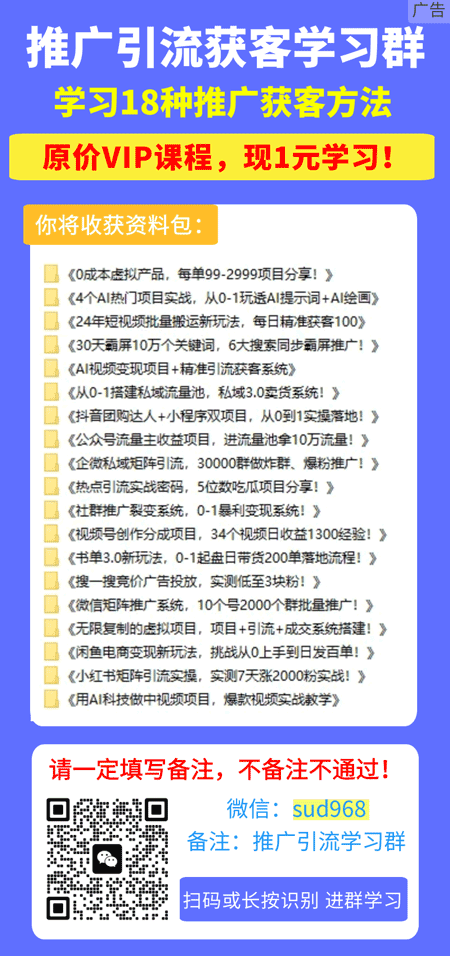数字营销是利用数字技术和互联网平台进行产品营销和推广的方式。数字营销包括搜索引擎优化(SEO)、搜索引擎营销(SEM)、社交媒体营销、内容营销以及电子邮件营销等多种形式。
对数字营销的误解有以下几种类别:
1. 数字营销仅限于广告投放:一些人误认为数字营销只是在互联网上投放广告,其实数字营销涵盖了更广泛的范围,包括内容创作、社交媒体互动、搜索引擎优化等多种手段。
2. 数字营销立竿见影:有些人错误地认为数字营销能够立即产生高回报,实际上数字营销是一个持续的过程,需要长期积累和耐心。
3. 数字营销成本低廉:一些人误以为数字营销成本低廉,其实数字营销需要专业的技术人员和优质的内容支持,而且在竞争激烈的市场中,数字广告投放成本也在不断上升。
4. 数字营销可以取代传统营销:有些人错误地认为数字营销可以完全取代传统广告和营销手段,实际上数字营销和传统营销手段可以相互结合,发挥协同效应。

数字营销是指利用数字技术和平台进行产品推广、品牌营销和销售的营销方式。数字营销通过互联网、移动设备和其他数字渠道与潜在客户进行沟通和互动,以实现营销目标。
对数字营销的误解主要有以下几类:
数字营销只是简单的在线广告:数字营销不仅仅是在线广告,还包括搜索引擎优化、社交媒体营销、内容营销等多种策略和技术。
数字营销就是无休止的推销:数字营销并不是一味地强调推销,而是通过建立品牌形象、提供有价值的信息和与客户互动来吸引客户,实现长期交流和合作。
数字营销结果立竿见影:与传统广告不同,数字营销通常需要长期持续的努力和投入,其效果可能需要时间才能显现,需要有耐心和长远眼光。
数字营销就是网络红人:数字营销包括了网络红人的合作,但它更多是一种综合性的战略,通过多种数字渠道和技术来进行品牌推广和营销。
营销人员对数字营销的误解有哪几类?
数字营销的误解通常包括以下几种:
- 数字营销是通过运用一些数字化的工具管理市场部活动的过程。
- 数字营销是网络推广。
- 数字营销是采用数字化方式精准触达用户以获取流量的过程。
- 数字营销是将线下营销活动转移到线上来。
- 数字营销是直播带货。
- 数字营销是自动化进行线索培育和孵化的营销方式。
这些解释都有一定道理,但又不够全面。它们都是数字营销内容的一部分,只是从不同角度进行诠释。然而,以上这些解释都无法完整反映数字营销的全貌。
- 第一点是从使用新营销工具进行数字化应用和流程管理的角度对数字营销的解读;
- 第二点是相较于传统营销方式如电视、广播等等对数字营销的解读;
- 第三点是从数字化营销带来的红利角度进行解读,许多人认为数字营销就是以一种低成本的方式获得流量,但这其实是一种偏见;
- 第四点是从营销媒介发生的巨大变化对数字营销进行解读;
- 第五点是根据之前大火的营销新现象对数字营销进行解读;
- 第六点是对营销数字化技术及其带来的价值的诠释。
数字营销是做什么的?
许多在传统行业中工作多年的营销人员表示希望转型为数字营销人员,但却不清楚如何进行转型。我们建议他们首先要弄清楚数字营销的工作内容。这一步骤非常重要,特别对于长期在大型企业的传统行业中工作的人来说,这并不是一件容易的事情。
营销的本质是实现增长,无论是收入、利润还是市值的增长,都属于这个范畴。尽管公益营销和为了长期愿景和使命而做出的品牌营销也有存在的理由,但这仅仅是冰山一角。企业始终以盈利为目标,因此,基于增长法则的营销活动才更有长期价值。
数字营销的含义在数字化的今天发生了变化,数字化营销驱动的不只是流量的增长,更是“服务小众、服务长尾用户能力”的增长。在过去,我们一直都在追求流量的增长,“流量”成为营销人员趋之若鹜的关键营销目标,但在新营销时代,流量增长不再是核心指标。
我们对数字营销的定义是:数字营销是企业在消费者的注意力被分散的时代,利用数字化工具精细化运营,通过提供有价值的内容来满足用户的长尾需求,从而提高用户的留存量,实现品牌效果和销售效果的协同营销。在这里,“留量”指的是用户的留存量,而不是短暂的“流量”。
传统时代的营销模式通常是将相同的广告推送给大量用户,用户接收到的信息都是相似的。然而,在当今社会,消费者的需求不断升级,他们希望获取信息和选择内容时更具有个性化和差异化,他们渴望与品牌建立更紧密的联系。在这种情况下,数字营销通过数字化的渠道、技术和工具能够更好地满足消费者多样化和个性化的需求。
数字营销驱动的企业的业务增长核心体现在扩大“用户覆盖和提升运营能力”上。用户运营能力的理解主要包括以下几个方面:
- 首先是可规模化,通过数字化的渠道规模化触达更多的受众,提升营销效率,降低企业运营成本,加速获取新客,这是数字化营销广度的优势体现;
- 其次是通过数字营销的方式和用户建立 1 对 1 的关系,以用户注意力为中心,建立与消费者的深度连接,这是数字营销方式与传统营销方式的显著区别。变化随时在发生,所以我们每一次的传播活动都需要对用户进行重新定位。
数字营销的本质在于将艺术和科学相结合,利用大数据赋予我们实现精准人群触达和转化的可能性。换言之,数字营销的重点已经从关注整体营销转移到了关注个体用户需求的方向。多样化的数字触点和大数据为企业提供了以用户喜闻乐见的方式建立特定关系的机会。这体现了数字化营销所具备的深度优势。
数字营销需要同时关注广度和深度,这也正是长尾理论的核心所在,即覆盖广泛的用户群体并进行深度的互动。因此,可以说长尾理论与数字营销的本质是一脉相承的。
欢迎关注产业媒体数字化转型网,这里提供丰富的营销数字化相关资讯、干货、案例和观点。如果您对数字化营销感兴趣,可以通过关注产业媒体数字化转型网获取更多有价值的信息。
翻译:
Digital marketing refers to the use of digital channels such as websites, social media, search engines, email, and mobile apps to promote products or services. It encompasses various marketing strategies and tactics aimed at reaching and engaging with a target audience online.
Some common misconceptions about digital marketing include:
1. It's only for large businesses: In reality, digital marketing can be just as effective for small and medium-sized businesses. With the right strategies, even small businesses can reach and engage with their target audience online.
2. It's only about social media: While social media is an important part of digital marketing, it's not the only channel. Digital marketing encompasses a wide range of channels and tactics, including search engine optimization, content marketing, email marketing, and more.
3. It's only about getting more website traffic: While increasing website traffic is a common goal of digital marketing, it's not the only objective. Ultimately, the goal is to drive meaningful engagement and conversions, such as leads or sales.
4. It's easy and requires little effort: Effective digital marketing requires careful planning, implementation, and ongoing optimization. It's not a one-size-fits-all solution and requires continuous effort and adjustment to achieve success.
5. It's only for selling products: Digital marketing can be used for a variety of purposes, including brand awareness, customer retention, lead generation, and more. It's not limited to just selling products or services.
Some misconceptions that marketers have about digital marketing include the belief that digital marketing is easy and quick, that it is only suitable for certain types of businesses, and that it is solely about social media. Additionally, some mistakenly think that digital marketing guarantees immediate results and that it is only effective for reaching a younger audience.
Here are some common misconceptions that marketers often have about digital marketing:
Digital marketing involves the use of various digital tools to execute and manage marketing activities.
Digital marketing involves promoting products or services through various online channels.
Digital marketing involves effectively reaching out to consumers through digital channels in order to drive traffic.
Digital marketing involves the migration of traditional marketing strategies to the online environment.
Digital marketing is vital for promoting goods and services in today's competitive market.
Digital marketing is the process of promoting and selling products or services using online platforms and technologies to reach and engage with potential customers.
This statement reflects the complex nature of digital marketing, where truth and interpretation intertwine. While these perspectives all contribute to digital marketing content, none alone provides a complete understanding of the subject.
The initial point involves interpreting digital marketing through the lens of digital application and process management, using new marketing tools.
The next aspect to consider is comparing digital marketing with traditional methods like TV and radio in terms of interpretation.
The third point involves interpreting the dividend from the perspective of digital marketing. While many believe that digital marketing is solely about acquiring low-cost traffic, this is actually a common misconception.
Point number four involves the interpretation of digital marketing in light of significant changes in marketing media.
Interpreting digital marketing in light of the latest marketing trends is the fifth priority.
The next point covers the significance of digital marketing technology and the benefits it offers.
Digital marketing utilizes online platforms and technologies to promote and advertise products and services. It allows businesses to reach a wider audience, engage with potential customers, and create brand awareness through methods such as social media marketing, content marketing, search engine optimization (SEO), and email marketing. Overall, digital marketing aims to drive traffic, increase sales, and build a strong online presence for businesses.
Many experienced marketers from traditional industries express a desire to transition into digital marketing, but they often struggle with knowing where to start. Our advice is to gain a thorough understanding of digital marketing. It's crucial not to underestimate this initial step, especially for seasoned professionals deeply entrenched in established corporate environments.
Marketing is fundamentally about driving growth, whether it's boosting revenue, increasing profits, or expanding market share, regardless of whether a company is well-established or new. While cause marketing and brand marketing are also important for a company's long-term vision and mission, they are just a part of the broader marketing landscape. Ultimately, businesses are profit-oriented, so marketing strategies focused on growth are crucial for delivering long-term value.
In today's digital world, the concept of "growth" in digital marketing has undergone a transformation. The new definition of "growth" driven by digital marketing encompasses not only an increase in traffic, but also the expansion of the capacity to cater to niche and long-tail users. While traffic growth used to be the primary focus for marketers, in the current marketing landscape, it is no longer the central metric.
In the current era of divided consumer attention, our definition of digital marketing is a marketing approach in which businesses capture users' niche needs through valuable content using digital tools as the foundation. This method focuses on carefully retaining users to achieve collaborative marketing effects. It's worth noting that the term "retention" here specifically refers to retaining users, as opposed to pursuing temporary "traffic."
In the traditional era, marketing relied on pushing the same advertisement to a large audience simultaneously, resulting in uniform information reception by the users. However, contemporary consumer demands have evolved, and individuals now seek personalized experiences and relevant brand connections in the midst of abundant information and content. This shift has made it essential for marketing strategies to adapt. Digital marketing has emerged as a solution, leveraging digital methods, technologies, and tools to meet the diverse and individualized needs of consumers.
The success of digital marketing-driven businesses can be seen in the increasing "user reach and operational capabilities." What does user operation capability entail? It is primarily showcased in the following areas:
One of the major advantages of digital marketing is its ability to reach a wider audience through digital channels, which ultimately leads to improved marketing efficiency, reduced operating costs, and faster customer acquisition.
The next step is to use digital marketing to establish a direct relationship with users, focusing on capturing user attention and building a strong connection with consumers. This sets digital marketing apart from traditional marketing and requires us to continually adjust our communication campaigns to retarget users effectively due to the ever-changing nature of the digital landscape.
Digital marketing integrates art and science, leveraging big data to achieve precise audience targeting and conversion. In essence, the emphasis in digital marketing has shifted from a broad marketing approach to tailoring strategies to meet the needs of individual users. The abundance of digital touchpoints and big data enables companies to cultivate personalized connections that resonate with users, showcasing the depth and potential of digital marketing.
The nature of digital marketing requires an understanding of both "broad" and "in-depth" strategies. The long tail theory underscores the importance of reaching a wide audience and engaging deeply with them, aligning closely with the essence of digital marketing.
You can find more insightful content on marketing digitalization, including valuable resources, case studies, and expert opinions, through the Industrial Media Digital Transformation Network.

如若转载,请注明出处:https://www.shangmengchina.com/42491.html
